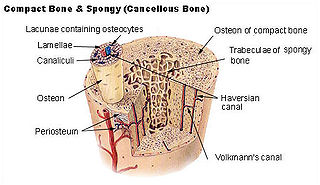
Haversian canals
Encyclopedia

Osteon
The osteon, or Haversian system, is the fundamental functional unit of much compact bone. Osteons, roughly cylindrical structures that are typically several millimeters long and around 0.2mm in diameter, are present in many of the bones of most mammals, birds, reptiles, and amphibians.Each osteon...
s are arranged in parallel to the long axis of the bone. The Haversian canals surround blood vessels and nerve cells throughout the bone and communicate with osteocytes in lacunae
Lacuna (histology)
In histology, a lacuna is a small space containing an osteocyte in bone or chondrocyte in cartilage.-Bone:The Lacuna are situated between the lamella, and consist of a number of oblong spaces. In an ordinary microscopic section, viewed by transmitted light, they appear as fusiform opaque spots...
(spaces within the dense bone matrix that contain the living bone cells) through canaliculi
Canaliculus (bone)
Canaliculi are microscopic canals between the various lacunae of ossified bone. The radiating processes of the osteocytes project into these canals. These cytoplasmic processes are joined together by gap junctions. Osteocytes do not entirely fill up the canaliculi. The remaining space is known...
. This unique arrangement is conducive to mineral salt deposits and storage which gives bone tissue its strength.
In mature compact bone most of the individual lamellae form concentric rings around larger longitudinal canals (approx. 50 µm in diameter) within the bone tissue. These canals are called Haversian canals. Haversian canals typically run parallel to the surface and along the long axis of the bone. The canals and the surrounding lamellae (8-15) are called a Haversian system or an osteon. A Haversian canal generally contains one or two capillaries and nerve fibres.
External links
- http://www.lab.anhb.uwa.edu.au/mb140/
- Youtube, Youtube video of Haversian canal system within cortical bone

